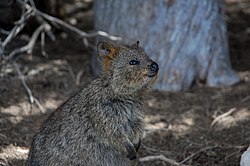Quokka
The quokka (Setonix brachyurus) is a small marsupial about the size of a large cat.[2] Like other animals in the macropod family, such as kangaroos and wallabies, the quokka eats grass and small plants, and is mainly nocturnal. It lives on some small islands off the coast of Western Australia, mainly on Rottnest Island near Perth, and Bald Island near Albany. A small number live on the main land in the protected area of Two Peoples Bay, which they share with Gilbert's Potoroo. The quokka is the only member of the genus Setonix.
| Quokka | |
|---|---|

| |
| Conservation status | |
| Scientific classification | |
| Kingdom: | |
| Class: | |
| Infraclass: | |
| Order: | |
| Family: | |
| Subfamily: | |
| Genus: | Setonix Lesson, 1842
|
| Binomial name | |
| Setonix brachyurus | |
Description
The quokka weighs between 2.5 kg (6 lb) and 5 kg (11 lb). It is around 50 cm (20 in) long with a 30 cm (12 in) tail. This is short for a macropod. It has a solid build, rounded ears, and a short, broad head. It looks like a very small, fat kangaroo, but it can climb small trees and shrubs. It has rough fur which is a brown colour, fading to pale brown underneath. The quokka eats a small amount of its waste products. It is about the size of a domestic cat.
Behaviour
The quokka is a social animal and lives in large groups. They eat grass, sedges, succulents and leaves. They can become very sick if fed with things like bread, given to them by visitors to Rottnest Island. Visitors are now told not to feed them. Quokkas breed at any time on the mainland, but usually in late summer on Rottnest. The female quokka has two babies (called joeys) in a year.
The quokka moves in the same way as a kangaroo, using both small and large hops.
Quokkas and people
Quokkas are not scared of people, so you are able to get quite close to them, particularly on Rottnest Island. It is against the law on Rottnest Island to handle or touch the animals in any way. A$100 fine can be given by the Rottnest Island Authority for picking up a quokka.[3] People can even be taken to court and get a fine of up to $1000.[4] These fines have been used in some unusual cases where quokka have been hurt or killed by visitors to Rottnest.[5]
Status
There are a lot of quokkas living on the small offshore islands, because this is only a small area they are listed as vulnerable. On the mainland, they are attacked by dingoes, as well as introduced animals like foxes, dogs and cats. They also need thick ground cover for shelter. Farming has cleared much of the land which is another reason the species is threatened.
European discovery
The quokka was one of the first Australian mammals seen by Europeans. The Dutch sailor, Samuel Volckertzoon wrote about seeing a "a wild cat" on Rottnest Island in 1658. In 1696, Willem de Vlamingh thought they were rats and named the island "Rottenest", Dutch for "rat nest".
Name
The word quokka comes from a Nyungar word, which was probably gwaga.[6]
Quokka Media
A quokka on Rottnest Island
References
- ↑ de Tores P., Burbidge A., Morris K. & Friend T. (2008). Setonix brachyurus. 2008 IUCN Red List of Threatened Species. IUCN 2008. Retrieved on 29 December 2008. Database entry includes justification for why this species is listed as vulnerable
- ↑ Groves, Colin (16 November 2005). Wilson, D. E., and Reeder, D. M. (eds) (ed.). Mammal Species of the World (3rd edition ed.). Johns Hopkins University Press. p. 69. ISBN 0-801-88221-4.
{{cite book}}: Check date values in:|date=(help);|edition=has extra text (help);|editor=has generic name (help)CS1 maint: multiple names: editors list (link) - ↑ Rottnest Island Regulations 1988 (WA), rr 40 & 73; sched. 4
- ↑ Rottnest Island Regulations 1988 (WA), r 40
- ↑ " Rare marsupials kicked to death in 'quokka soccer'" Archived 2004-08-21 at the Wayback Machine, The Daily Telegraph, 2003
- ↑ Dixon, R.M.W.; Moore, Bruce; Ramson, W. S.; Thomas, Mandy (2006). Australian aboriginal words in English: their origin and meaning (2nd ed.). Oxford: Oxford University Press. ISBN 0-19-554073-5.
{{cite book}}: CS1 maint: multiple names: authors list (link)
Other websites
Facts Status Description Range Habitat Biology Threats Conservation Find out more Glossary References View all
| Wikimedia Commons has media related to Lua error in Module:Commons_link at line 62: attempt to index field 'wikibase' (a nil value).. |




